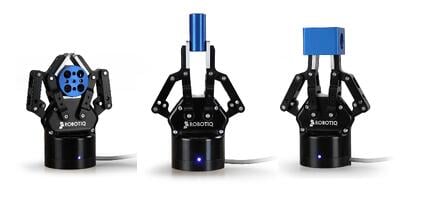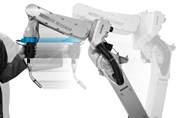Different End Effectors on the Market

Posted on Jul 03, 2013 in Robot Grippers
4 min read time
Nowadays, robots are part of many manufacturing processes and aspects of production are improved by using them. Their repeatability and consistency improve product quality by reducing scrap. Moreover, they help save money because they can work non-stop during long periods of time. Since they are fast, they also reduce cycle time. All these facts prove that robots are valuable assets for manufacturers.
However, a robot arm alone can hardly accomplish any job. This is why each manufacturing robot needs an end effector. By definition, an end effector is the device at the end of a robotic arm that allows it to interact with its environment.
There are different types of end effectors, but we can class them into two basic categories: Robot Grippers and Robotic Tools. Let’s take a look at their different features.
Robot Grippers
Electric Grippers

Electric grippers use motors to make their fingers move. Their advantages are that speed and position can easily be controlled. Adaptive electric end effectors are a good fit for many applications such as: bin picking, handling, machine tending and more.
Pneumatic Grippers

Pneumatic grippers use air to make them work. Usually, compressed air is forced through a piston in order to make it move. This movement can be parallel or angular. For more information about this kind of end effector, you can read the following article : How pneumatic end effectors work?
Suction Cups

Suction cups are simple devices that use vacuum to grab parts. They are low cost and give good flexibility for material handling. They can be use with many types of material, but cannot handle perforated parts. Learn more on suction cups by clicking here.
Magnetic Grippers

This kind of end effector is similar to suction cups, but can just be used with ferrous material. Moreover, they don't have an associated air cost and won’t drop any material during air loss or power outages. They are also simple and require low maintenance.
Robotic Tools
Robotic Welding

A robot arm can also be used with a welding end effector. This kind of match is often seen in the automotive industry. A robot will give great results in a welding application, because of its consistency and precision. A lot of developments have been made in order to improve crossover implementation of these robots in more industries. New devices have been designed to help employees work with them. A great example is the Kinetiq Teaching end effector by Robotiq. With this new device teaching welding trajectories is simplified. No more need to have in-depth knowledge in programming. Welders will be able to hand guide welding robot, record key points of the welding path and adjust welding parameter on-the-fly with the teach pendant.
Painting

Painting is a hard task because the application has to be smooth and regular. Since contamination is a major issue, painting cells are often in a closed and controlled environment. Therefore, painting robots are good asset for producing quality work and reducing contamination risks. Moreover, volatile paint is a health issue for human painters.
Custom tools
The other group of end effectors can be called custom tools. Either for drilling, cutting or other applications, a personalized end effector can be designed.
In conclusion, there is an end effector for each application on the market. Since the robotic industry is constantly evolving, new designs are always being introduced to manufacturers. So, we need to be aware of the new technologies entering the market.


.jpg)





Leave a comment